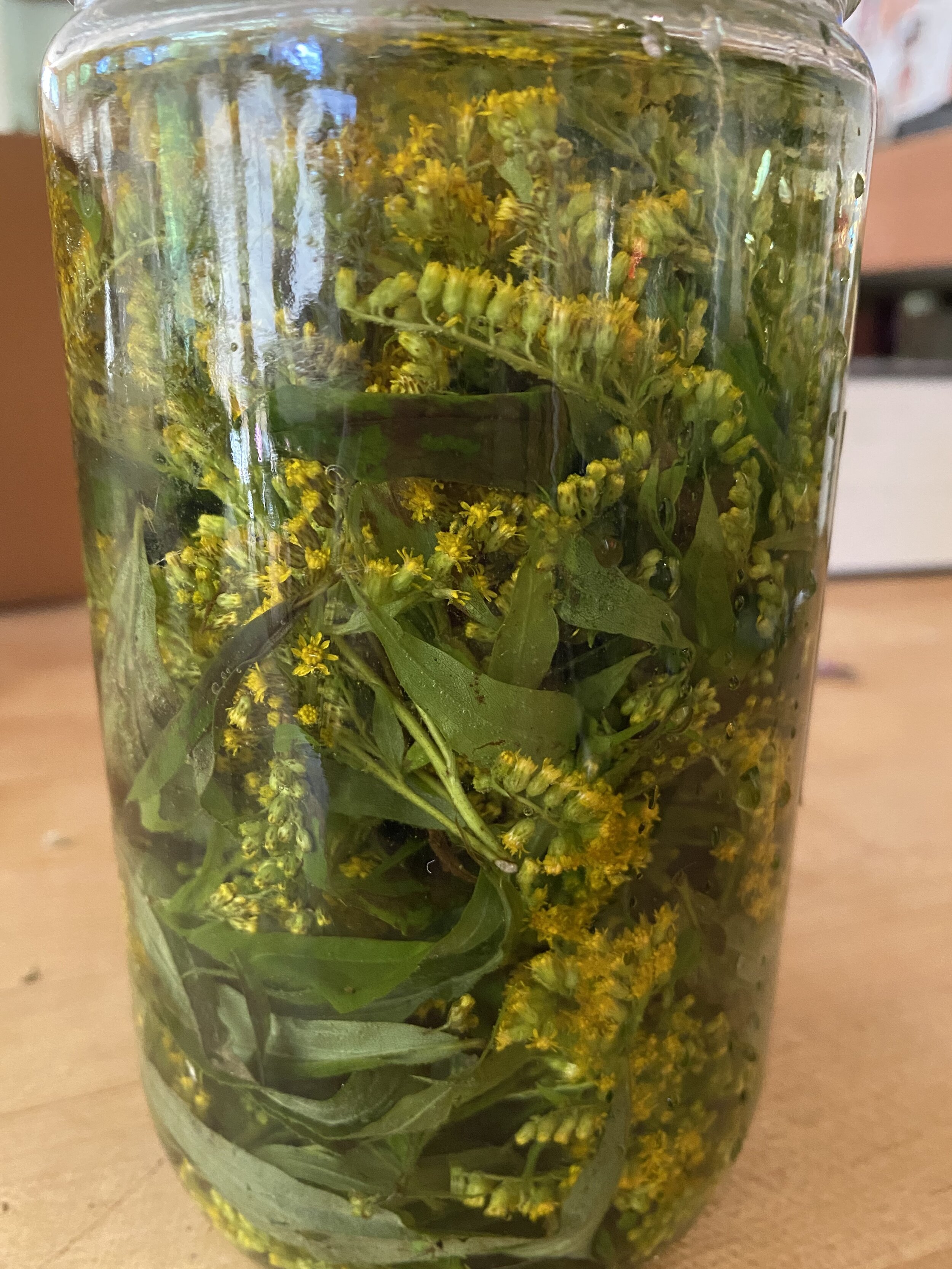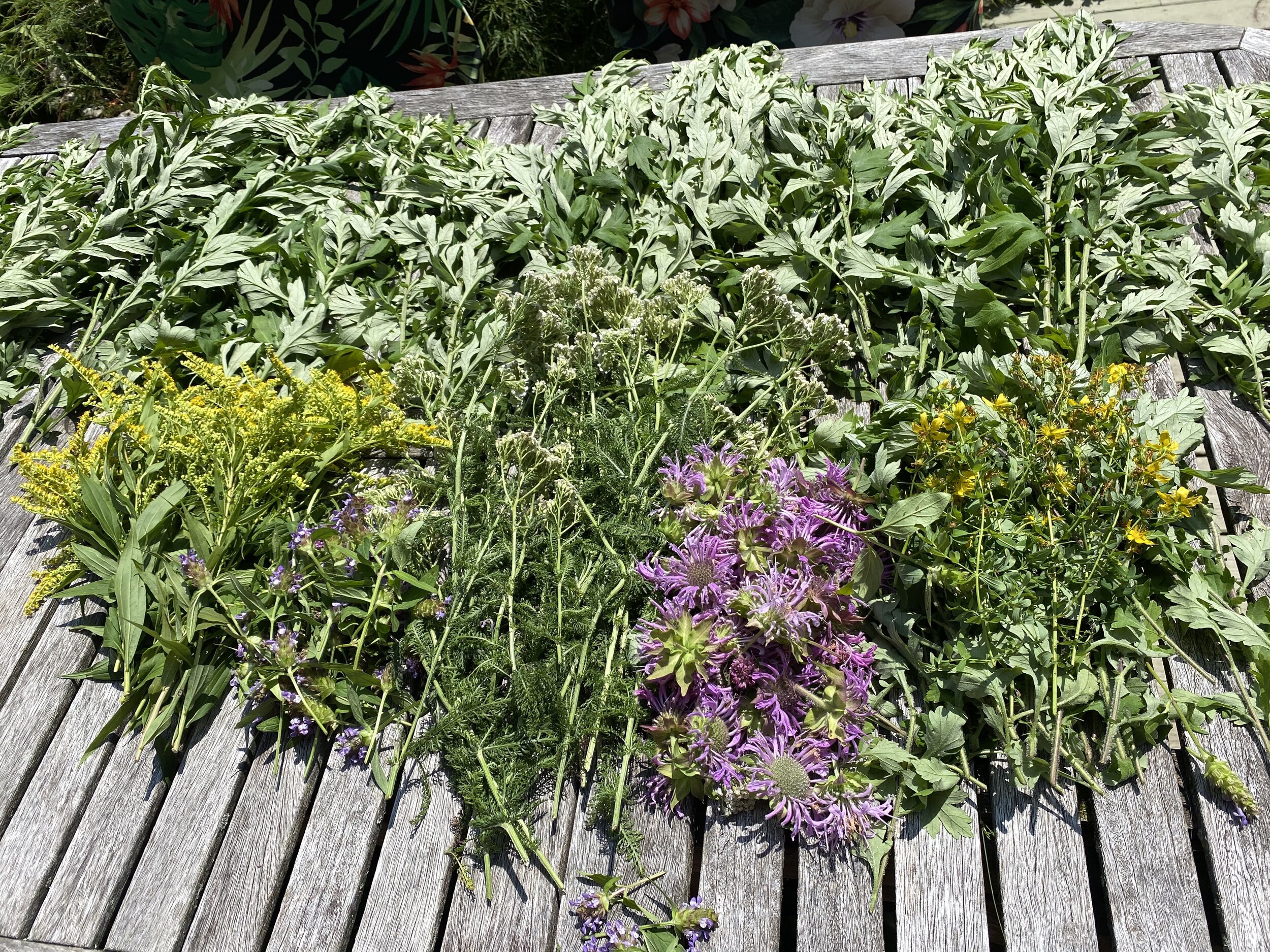MAKING MEDICINE
BEE BALM & GOLDEN ROD TINCTURE
Most herbalists chop up their plant matter before macerating to release more medicine into the tincture, but I love the beauty of whole flowers steeping in alcohol. So, I leave my flowers whole for a couple of weeks so I can soak in their beauty as they steep. I love watching the colors change as the medicine leeches out of the herbs and into the alcohol. For me, this is part of the therapeutic benefit for myself- beholding the beauty, and watching the process.
Growing, harvesting, and foraging for medicinals is also incredibly healing for me- reconnecting me to nature, and time- forcing me to slow down and notice. In my formal training in Chinese Medicine/ East Asian Medicine, we miss this valuable and pleasurable component of medicine making. Our herbs come to us processed- pills, powders, and not so often in my practice, dried. So, I've decided to add some East Asian herbs into my medicine gardens!
This week I harvested and tinctured wild bee balm (purple vs red) and golden rod.
WHAT IS BEE BALM GOOD FOR?
Bee Balm is a great all around herb that is used by herbalists to help with colds, flu, upper respiratory problems, gas, diarrhea, nausea, urinary tract infections, fevers and whooping cough, fungal infections (both internal and external), and topically for skin problems, wounds, and burns. Gargling with a strong tea made of bee balm can help alleviate mouth and throat pain. Used as a compress, the leaves of this gorgeous and fragrant plant can ease the discomfort of headaches, sore eyes, and muscle spasms. Bee Balm is a qi mover- it helps move stagnant energy and substances through the body.
DEBUNKING THE GOLDEN ROD ALLERGY MYTH
I find it ironic and sad that Golden Rod is often mistaken for Rag Weed, which is a major culprit in mid summer seasonal allergies. In fact, Golden Rod is a great remedy for sinus and respiratory congestion! Go slow with her though, as she can be very drying. Because of this property, Golden rod is also used for urinary tract infections and edema.
EATING BEE BALM
Food is medicine and medicine and medicine can be food too!
Eating flowers is one of my favorite things to do. A few years ago, my friend and Western herb mentor @jencosta_eldermoonherbs introduced me to bee balm chimichurri. Not only is it delicious, it’s beautiful too. It’s got a distinctive slightly spicy flavor that is similar to both thyme and oregano. Simply toss the petals into a food processor with other fresh culinary herbs of your choice (oregano, cilantro, mint, parsley) with chopped garlic, olive oil, a dash of lemon juice and salt. Pulse until finely chopped. Store in the fridge for up to 2 weeks. I eat this straight out of the jar, but it’s also good on crostini with goat cheese, spread on crackers, on fish or poultry, or as a base for salad dressing.
GOLDEN ROD HONEY
Making herbal honey is a great way to preserve herbs and also handy for those of us with kids who yuck herbs.
To make an herbal honey, chop the plant matter finely. Put in a jar, toss and cover with honey, making sure no parts of the plant are uncoated. The liquid from the plants will thin the honey out, so make sure to leave headroom in the jar. Give it a gentle shake or a stir with a clean utensil every day. I leave the herbs in the honey and strain them out when I make honey herb tea or honey lemonade /seltzer for my kids. Check periodically to make sure the honey isn’t fermenting (which I don’t see as a bad thing!).


